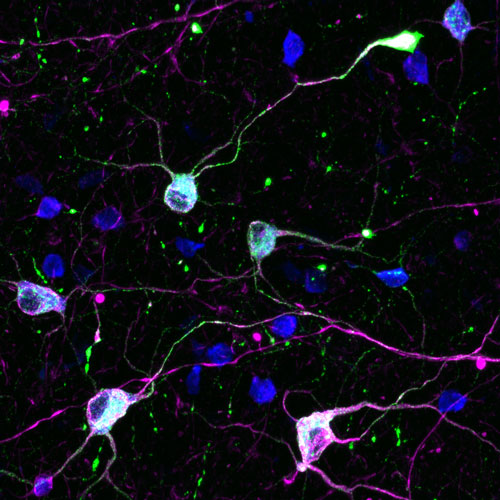Injury to the mammalian central nervous system (brain, spinal cord or retina) usually leads to irreversible loss of function. This is because many injured neurons die and those that survive are generally unable to regrow their axons, which are needed to form connections with their partners. The retina is a convenient system in which to study processes of neuronal degeneration and regeneration, due to its experimental accessibility. Neurons in the retina, called retinal ganglion cells (RGCs), relay visual information to the rest of the brain through their axons, which make up the optic nerve. Optic nerve crush injury, which severs the axons of RGCs, results in the death of ~80% of these neurons within 2 weeks.

Figure: Retinal ganglion cells (RGCs) in the adult mouse retina are made up of 46 distinct molecular types, which differ in their ability to survive after injury. This image shows immunolabeling of RGCs (RBPMS, blue) that have survived through 2 weeks after optic nerve crush injury, when ~80% of RGCs are lost. These resilient RGCs are enriched for specific types, including certain Alpha-RGCs (SPP1, green and SMI32, magenta). Credit: Dr. Nicholas Tran.
RGCs are not a homogenous population; earlier work by the Sanes group and others has shown that there are in fact many types of RGCs, which differ morphologically, molecularly and functionally. In our current work, we sought differences in the ability of distinct RGC types to withstand injury, hypothesizing that genes selectively expressed in resilient or vulnerable types could be involved in their differential survival. First, we generated a “molecular atlas” of RGC types using high throughput single-cell RNA sequencing; by profiling gene expression in each of >35,000 individual RGCs, we discovered that there are 46 types in the adult mouse retina. We repeated the analysis after optic nerve crush to determine the fraction of each type that survived through 2 weeks post injury, and found dramatic differences, ranging from 1% to 98% survival. With our atlas as a reference, we looked for genes selectively expressed in the most resilient or vulnerable types. We chose several of these genes and manipulated their expression in vivo. By increasing the expression of genes associated with resilience, or decreasing the expression of genes associated with vulnerability in injured RGCs, we were able to improve their survival after injury. This included rescuing some types that were extremely vulnerable when left untreated. Excitingly, perturbing some of these genes not only enhanced the survival of RGCs, but also stimulated regrowth of their axons towards the brain, which is a required next step towards functional recovery.
RGCs are crucial for vision, and are the target in many blinding conditions, such as glaucoma. Exploring the targets we uncovered in this study could be applicable to a variety of such conditions. Furthermore, differential neuronal resilience to injury or other insults is a phenomenon that extends beyond the retina and optic nerve, and is seen in many neurodegenerative settings. Thus, our approach could be adopted as a strategy for finding ways to protect and regenerate damaged neurons.


































